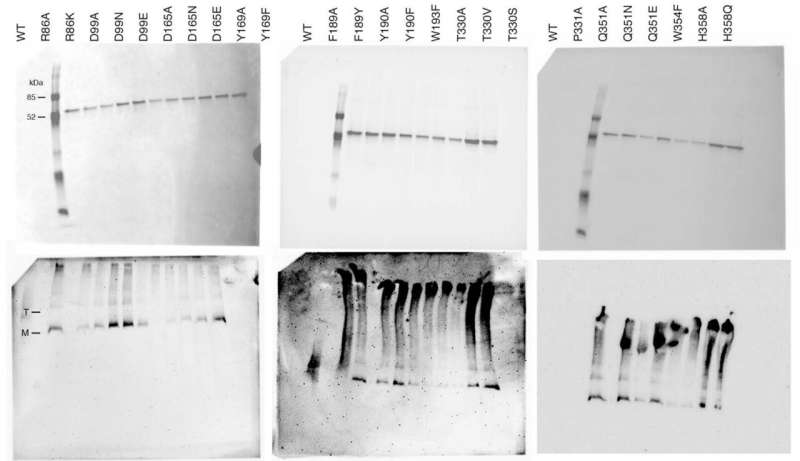This article has been reviewed according to Science X's editorial process and policies. Editors have highlighted the following attributes while ensuring the content's credibility:
fact-checked
trusted source
proofread
How insects tell different sugars apart

Whereas humans have one receptor on their tongues that can detect all sorts of sweet things, from real sugar to artificial sweeteners like aspartame, insects have many receptors that each detect specific types of sugars. Yale researchers have now uncovered one way insect receptors are able to be so selective, an insight they say will help us understand how animals decipher the chemical world and how we might mimic that ability in the future.
They reported their findings in a study published in Nature.
Sugar is important to animals and humans alike, says Joel Butterwick, assistant professor of pharmacology at Yale School of Medicine and senior author of the study.
"We all taste sugar. It's a major source of energy for just about every animal," said Butterwick.
The ability to taste sugar is also essential for identifying necessary nutrients and generating a pleasurable feeling that becomes paired with nourishment. Different than mammals, insects also rely on their taste system to detect mating partners and identify the best places to deposit their eggs.
But just how insects detect specific sugars—differentiating between molecules that look quite similar to each other but that have subtle differences—has remained unclear. To better understand the sensitivity of insect taste receptors, Butterwick and his research team focused on one receptor that is so selective it responds to only one type of sugar—D-fructose.
The receptor is one found in the mouths and brains of silk moths. As a ligand-gated receptor, it becomes activated only after its ligand—the molecule that's able to bind to it—attaches.
Unexpectedly, even though D-fructose is the only sugar that activates this receptor, the researchers found that several other sugars bind to it, the researchers said.
"That told us that the area where these sugars attach, the binding pocket, isn't the only thing determining activation," said Butterwick. "There had to be some other explanation. So we wanted to look at the receptor at the atomic scale to see in detail how the sugar and receptor were interacting."
The team mapped the structure of the receptor alone as well as the receptor bound to D-fructose. They observed that D-fructose was nestled into the binding pocket and initiated a shape change that activated the receptor.
They then mapped the structure of the receptor when it was bound to a sugar extremely similar to D-fructose. While that sugar, L-sorbose, did appear to bind to the receptor just as well as D-fructose, it didn't change the receptor's shape, leaving the receptor inactive. The difference between the two sugars turned out not to be how they attached to the binding pocket but how they interacted with a molecular bridge that connects the binding pocket to a different part of the receptor.
In short, D-fructose was able to engage that bridge and initiate the shape change, and L-sorbose was not.
"What we think is interesting about that is that there are interactions happening outside of the pocket that act as a mechanism of selection," said Butterwick. "And evolution likely works on both aspects. For example, a less specific receptor than this one may bind more molecules, or maybe its bridge is easier to activate. With multiple aspects to act upon, there are more ways for evolution to fine-tune these receptors."
Uncovering the mechanisms that underlie how receptors recognize various substances will help researchers understand how smell and taste enable humans and animals to decipher the chemical world, says Butterwick.
It could also inform the development of biosensors, he added. Some dogs can smell diseases like cancer or Parkinson's disease. Knowing how smell and taste receptors differentiate substances would aid the development of "electronic noses" that could sniff out disease.
"People are already trying to do this. And while there have been a few successes, there have been more failures," said Butterwick. "Our work here may help explain why it has been challenging. It's not just about binding the molecule of interest. How the receptor activates is also essential."
Going forward, the researchers want to explore the pharmacological potential of these receptors.
"There have been countless cases throughout history where a solved atomic structure paved the way to major discoveries," said João Victor Gomes, a graduate student in Butterwick's lab and lead author of the study. Gomes is from Brazil, which is currently facing a severe dengue surge, with more than one million cases of the mosquito-borne disease registered this year alone.
"If we can modulate receptors that affect the feeding behavior of insects," he said, "perhaps we could develop better strategies against disease-transmitting mosquitoes."
More information: Gomes, J.V.T., Singh-Bhagania, S., Cenci, M. et al. The molecular basis of sugar detection by an insect taste receptor. Nature (2024). DOI: 10.1038/s41586-024-07255-w. www.nature.com/articles/s41586-024-07255-w
Provided by Yale University



















